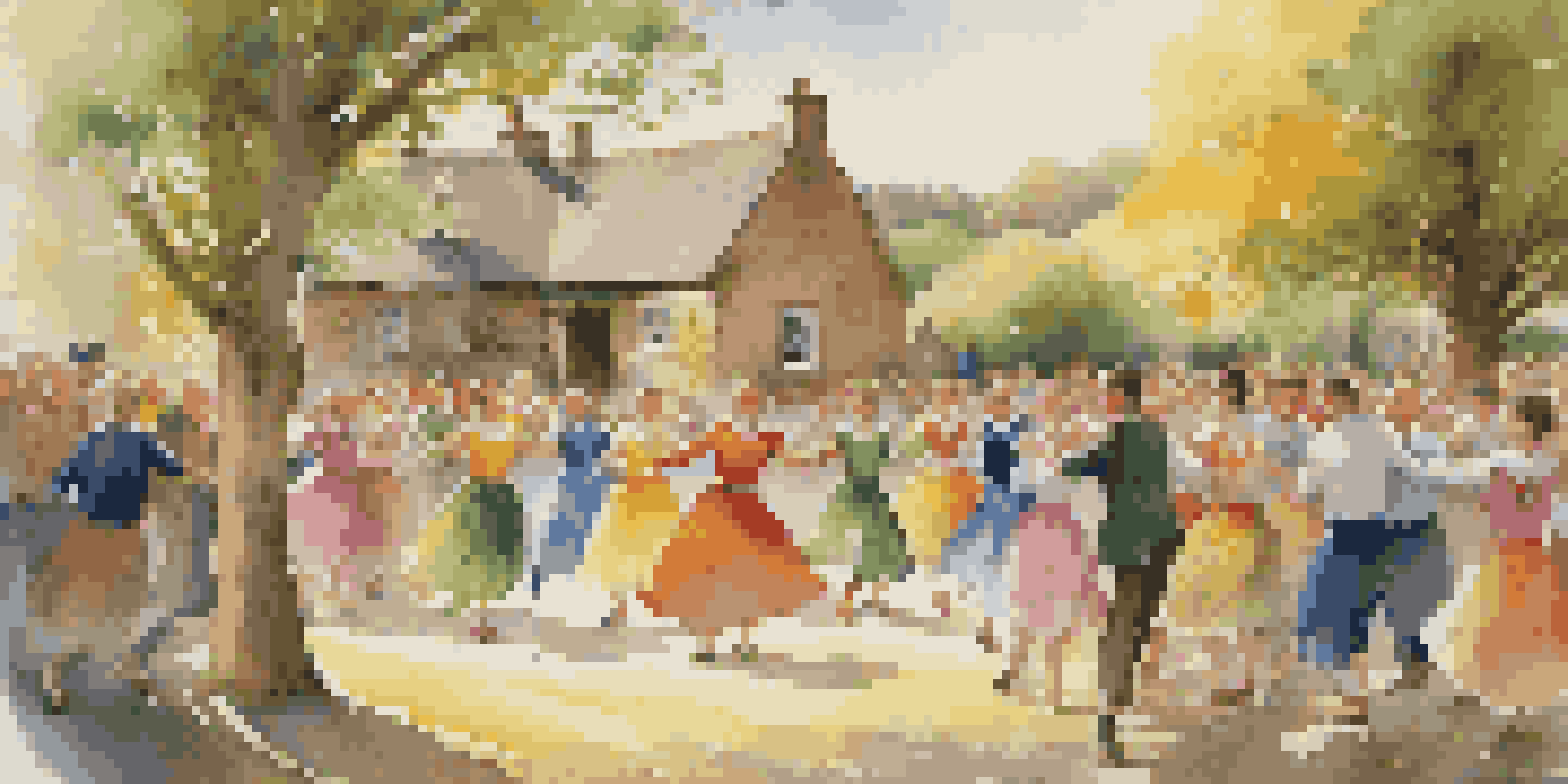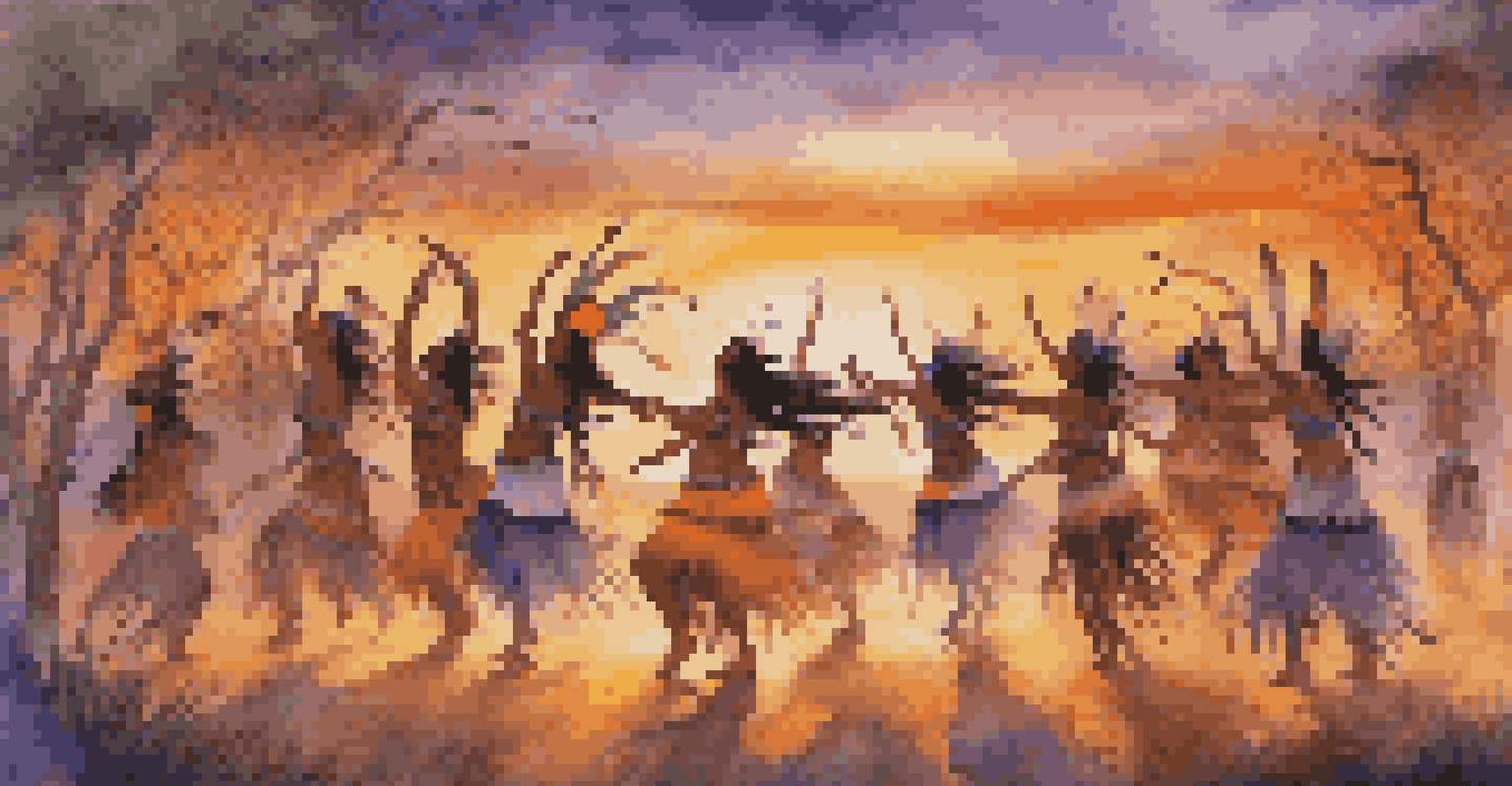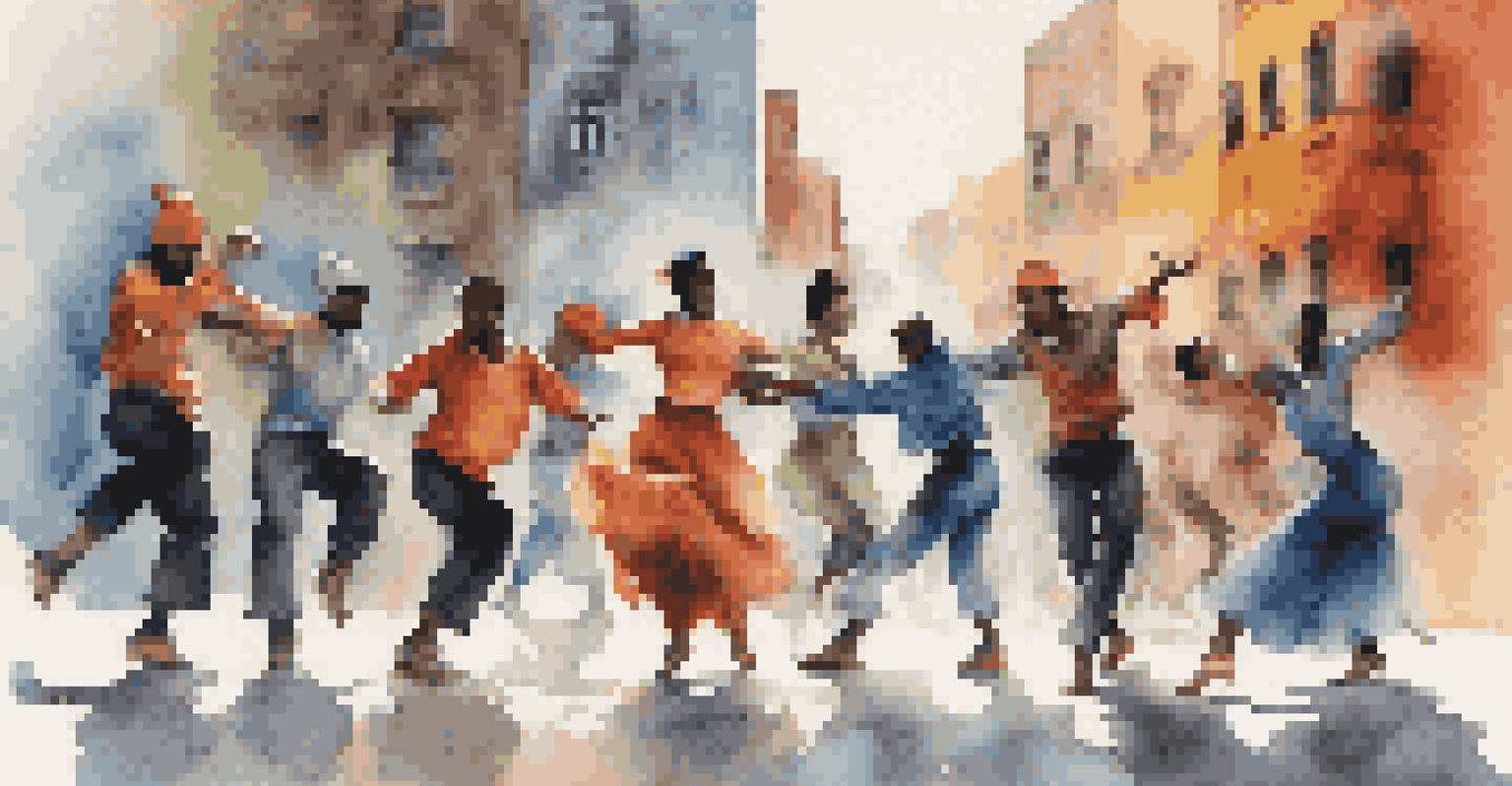Interpreting Folklore Themes in Traditional Dance Forms

The Role of Folklore in Cultural Identity
Folklore serves as a vital thread in the tapestry of cultural identity. Through stories, songs, and dances, communities express their unique traditions and values. For instance, dances like the Irish jig are not just artistic expressions; they encapsulate the history and spirit of the Irish people. This connection between dance and folklore deepens our understanding of cultural heritage.
Folklore is the most ancient form of literature, and it is a reflection of the people who tell it.
When people engage in traditional dance, they often feel a sense of belonging, as if they are part of something larger than themselves. This communal aspect fosters connections between generations, allowing elders to pass down stories and movements to younger participants. Such exchanges are pivotal in keeping folklore alive and relevant.
Moreover, the themes in folklore often reflect the societal values and struggles of the time, offering insights into historical contexts. For example, dances that celebrate harvests or seasonal changes highlight the agricultural roots of a community, showcasing their dependence on nature. Thus, folklore themes in dance not only entertain but also educate about cultural identity.
Exploring Common Folklore Themes in Dance
Traditional dance forms often embody recurring themes from folklore that resonate across cultures. Love, conflict, and nature are common motifs that dancers portray through movement. For instance, the passionate tango vividly illustrates themes of love and longing, while Native American dances often celebrate nature and the changing seasons. These themes serve as a universal language that transcends cultural boundaries.

In many cultures, dances are used to tell stories that convey moral lessons or historical events. The African griot tradition uses dance alongside music to narrate tales of ancestry and bravery. This storytelling aspect is essential, as it not only entertains but also imparts wisdom and values to the audience, making folklore themes tangible.
Folklore Shapes Cultural Identity
Folklore is essential in expressing a community's traditions and values through storytelling, dance, and music, fostering a sense of belonging.
Additionally, the incorporation of folklore themes in dance can serve as a form of resistance or commentary on societal issues. For example, the feminist undertones in some modern interpretations of traditional dances challenge gender roles and expectations. These layered meanings enrich the dance experience, inviting audiences to reflect on their own cultural narratives.
The Intersection of Dance and Storytelling
Dance and storytelling are intertwined art forms that enhance one another. Traditional dances often serve as a visual narrative, embodying the stories from folklore. Each movement, gesture, and expression can convey emotions, plot points, and character dynamics, creating a multi-dimensional experience for the audience.
Dance is the hidden language of the soul.
For example, in the ballet 'Romeo and Juliet', the choreography reflects the tragic love story through expressive movements that mirror the characters' emotions. Similarly, folk dances may illustrate tales of heroism or community gatherings, allowing performers to step into the roles of their ancestors. This storytelling aspect invites audiences to connect with the narrative on a deeper level.
Moreover, the integration of folklore themes in dance allows for the preservation of cultural narratives that might otherwise fade. When dancers embody these stories, they become living representations of their heritage, ensuring that the messages of the past resonate within contemporary culture. Thus, the intersection of dance and storytelling proves to be a powerful vehicle for cultural expression.
Symbolism in Traditional Dance Movements
Every traditional dance movement often holds symbolic meaning rooted in folklore. For instance, the circular formations seen in many dances represent unity and community, a reflection of the social bonds that folklore reinforces. Similarly, specific gestures may symbolize elements like fertility, strength, or spirituality, allowing dancers to communicate complex ideas non-verbally.
Additionally, colors, costumes, and music in traditional dances further enhance the symbolism at play. A vibrant red dress might signify passion or celebration, while rhythmic drumming can evoke ancestral connections. This rich tapestry of symbolism invites both performers and audiences to engage with the deeper meanings behind the dance.
Dance Reflects Universal Themes
Traditional dances convey recurring motifs such as love, nature, and conflict, serving as a universal language that connects diverse cultures.
As dancers embody these symbols, they become storytellers, translating folklore themes into a visual and auditory experience. This connection between movement and meaning enriches the performance, allowing it to resonate on multiple levels. Thus, understanding the symbolism in dance opens new avenues for appreciating the stories woven into cultural traditions.
The Evolution of Dance Forms and Folklore
Over time, traditional dance forms have evolved, often incorporating contemporary influences while still honoring their folkloric roots. This evolution can lead to a richer interpretation of folklore themes, as modern dancers reinterpret ancient stories through a contemporary lens. For example, hip-hop dance has integrated elements of various traditional forms, creating a vibrant dialogue between past and present.
However, this blending can also spark discussions about cultural appropriation and authenticity. As dance evolves, it's crucial to navigate these conversations with respect, ensuring that the original meanings and contexts of folklore are preserved. Dancers and choreographers can draw inspiration from traditional forms while remaining mindful of their cultural significance.
Through this evolution, new generations can connect with their heritage in ways that resonate with contemporary audiences. This ongoing dialogue between tradition and innovation ensures that folklore themes remain alive and relevant, continuously adapting to reflect the changing dynamics of society.
The Role of Dance in Preserving Folklore
Dance plays a significant role in preserving folklore, acting as a dynamic medium for storytelling and cultural transmission. By participating in traditional dance, individuals help to keep their community's stories alive, passing them down through generations. This preservation is vital, especially in a rapidly changing world where cultural identities are often at risk of being diluted.
Moreover, dance festivals and cultural celebrations provide platforms for communities to showcase their traditional dances, reinforcing their significance within the cultural landscape. These events not only celebrate heritage but also foster a sense of pride and belonging among participants. Through dance, individuals can express their cultural identity and share it with others.
Dance Preserves Cultural Narratives
Through participation in traditional dance, individuals help preserve folklore and cultural identity, ensuring these stories are passed down through generations.
Furthermore, educational initiatives that incorporate traditional dance into curricula can enhance awareness and appreciation for folklore. By teaching students about the stories behind the dances, we cultivate a deeper understanding of cultural diversity. This educational aspect ensures that folklore themes continue to thrive, making them accessible to future generations.
Conclusion: The Enduring Power of Dance and Folklore
In conclusion, the relationship between traditional dance forms and folklore themes is profound and multifaceted. Dance serves as a living archive of cultural identity, preserving stories, values, and experiences that define communities. By interpreting these themes through movement, dancers not only honor their heritage but also invite audiences to engage with the narratives of the past.
As we continue to explore and celebrate the intersection of dance and folklore, it's essential to remain mindful of the cultural significance behind these art forms. By respecting and preserving the original meanings, we ensure that the stories continue to resonate in our contemporary lives. This balance between tradition and evolution enriches our understanding of both dance and folklore.

Ultimately, the enduring power of dance lies in its ability to connect us to our roots while simultaneously allowing for innovation. As we witness the evolution of traditional dance forms, we recognize that the themes of folklore will continue to inspire and inform our cultural expressions for generations to come.